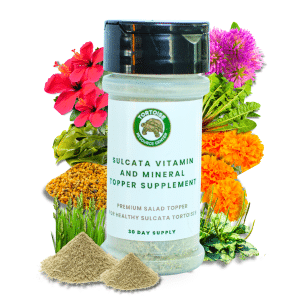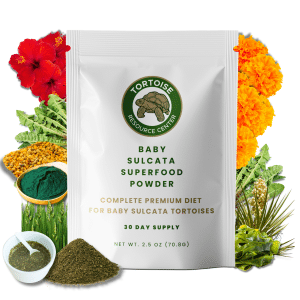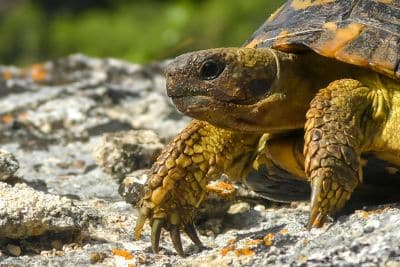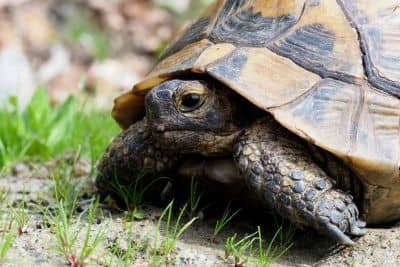The Sonoran desert tortoise and Mojave desert tortoise were formerly considered the same species, until DNA research revealed that they were two distinct entities, which inhabited opposite sides of the Colorado River.
When most reptile enthusiasts think about tortoises, they envision exotic species that inhabit tropical rainforests or deserts in faraway places. But there are actually several tortoise species that call the USA home, including a particularly endearing species, known as the Sonaran or Morofka’s desert tortoise (Gopherus morafkai).
More commonly known as the Morofka’s desert tortoise, this endearing tortoise has evolved a number of adaptations that allow it to survive in the inhospitable desert regions it calls home. It’s important that keepers understand these adaptations to ensure that the tortoises in their care thrive.
Morofka’s tortoises are not as commonly kept as some other tortoise species, and they’re protected across most of their range, making them illegal for many prospective keepers to own. But that doesn’t mean they can’t make good pets for those who’re legally entitled to maintain them.
In this article, I’ll share some of these key adaptations and provide a basic plan for caring for these chelonians below.
Basic Information
All tortoises have adapted to the environments in which they live, but because deserts present special challenges, the Morofka’s desert tortoise has had to develop several interesting adaptations to survive in the harsh landscape it calls home.
Physical Appearance
At first glance, Morofka’s desert tortoises look fairly normal by tortoise standards, and in many ways, they are. A medium-sized species, most adult animals average about 9 to 15 inches in length and weigh between 8 and 15 pounds (though occasional specimens may exceed this range).
They have elephantine feet like all other living tortoises, but the front legs of Morofka’s desert tortoises are slightly flattened relative to many other species. This is presumably an adaptation that facilities digging – an important behavior for these tortoises, which I’ll discuss in more depth later. Their front legs also bear distinct scales, which are likely to help protect the tortoise’s face when threatened by a predator.
These tortoises often have contrasting shell patterns when they’re young. They’ll typically feature a light-colored spot in the center of each scute, with a darker border region encircling the light spot. Some individuals continue to display this pattern as they mature, but others become more-or-less uni-colored with age, ultimately appearing tan to dark grey in color.

Natural Habitat & Range
As a group, tortoises of the genus Gopherus are found in several disconnected locations across the southern United States and Mexico.
Gopher tortoises (G. polyphemus) are found in the southeast, Texas tortoises (G. berlandieri) are found in Texas and portions of Mexico, Goode’s thornscrub tortoises (G. evgoodei) and Bolson tortoises are native to Mexico, Mojave tortoises (G. agassizii) are confined to the Mojave Desert region of California, Utah, Nevada, and portions of Arizona (west of the Colorado river), and Morofka’s tortoises are restricted to the Sonoran Desert region of Mexico and Arizona.
Within this range, the Morofka’s tortoise inhabits a variety of habitats, ranging from rocky hillsides to grasslands to tropical forests. However, these tortoises are almost always found in habitats that are quite dry.
Natural Behaviors
The single most noteworthy behavior of Morofka’s tortoises is their tendency to excavate long, deep tunnels. These tunnels are used to provide shelter from both temperature extremes and predators, and they likely help to slow water loss too. In some cases, these tunnels may extend more than 50 feet in length and 10 feet in depth.
Morofka’s desert tortoises exhibit a fairly typical daily activity pattern. They tend to rise early, leave their tunnels, and feed throughout the relatively cool morning hours. Then, once the midday temperatures start climbing, they’ll often return to their tunnels to avoid overheating. Some may become active again in the late afternoon, as the temperatures begin falling.
Morofka’s desert tortoises typically brumate each winter, once the nighttime temperatures begin falling below 50 degrees Fahrenheit. In doing so, they’ll retreat to their burrows and sleep for several months until spring arrives.
Breeding activity generally follows emergence from their burrows (it may also occur in the fall). Interestingly, males will develop prominent secretion-producing glands on the bottom of their chins during this time, which are thought to aid in species recognition. Males may engage in ritualized combat with other males, and both sexes will engage in head-bobbing displays when they encounter each other.
Eggs are laid several weeks after mating takes place. The young hatch about two to three months later and must fend for themselves, as no parental care is provided.
Captive Care: Maintaining a Morofka’s Tortoise
It’s important to understand that the Morofka’s tortoise is a highly protected species, which isn’t legal to keep in many areas. So, it is imperative that you research the laws and regulations in your state before deciding to keep one of these amazing animals.
With that said, these tortoises generally make undemanding pets, although their housing needs can be challenging to meet.
Enclosure & Space Requirements
As a medium-sized tortoise species, Morofka’s tortoises will require about 30 to 50 square feet of space as adults (hatchlings and juveniles can be kept in smaller enclosures). You can theoretically accomplish this indoors, but an outdoor predator-proof enclosure is almost always preferable.
This means you’ll likely have to construct a custom enclosure from scratch. You can do so in several ways, using a variety of different materials. However, most enclosures will consist of sturdy walls around the perimeter, and potentially a predator-proof top, made from chain-link fencing or hardware cloth. Properly sealed wood and cement blocks are two of the most common materials used for the enclosure walls, but plastic panels or corrugated metal pieces will also work.
But no matter what material you use for the enclosure walls, the most important thing to keep in mind when keeping these tortoises is underground security – these tortoises will dig very long, deep tunnels, so you’ll have to take steps to ensure your pets can’t escape.
You can do so by either installing walls that extend several feet below ground level or by including a subterranean “floor.” Just make sure that you don’t completely prevent your tortoises from digging tunnels, as this will lead to stress. Instead, you want to allow them to dig, while preventing them from tunneling under the enclosure walls.
Are You Starving Your Tortoise?
Save 10% on premium tortoise food and supplements from Tortoise Resource Center on Amazon now using code BUYNOWGET10

Sulcata Vitamin & Mineral Topper Supplement
30-Day Supply | 2 oz (56 g)
$24.99

Baby Sulcata Tortoise Superfood Powder
30-Day Supply | 2.5 oz (70.8 g) Bag
$24.99
Heating, Lighting, & Humidity
Because it is generally wise to keep Morofka’s desert tortoises outdoors, you won’t have to worry as much about providing proper heating and lighting – the sun will do this for you. However, it is crucial that you live in an area with a climate that’s similar to the climate these tortoises experience in the wild.
However, if you’re keeping a juvenile Morofka’s desert tortoise indoors, you will need to include heating and lighting devices to provide a proper thermal environment and ensure that your pet is exposed to full-spectrum lighting, which includes rays in the UVA and UVB portions of the spectrum.
This can unfortunately be a little complicated, as there are several different ways to satisfy these requirements. Some types of lights provide heat and light, while other types of lights only provide heat or full-spectrum lighting.
Most keepers use one or more of the following devices to keep their tortoise healthy and happy:
- Mercury vapor lights: Mercury vapor lights are the only option that produces both significant heat and full-spectrum lighting, including rays in the UVA and UVB portions of the spectrum. However, they are somewhat more expensive than other types of reptile lighting systems.
- Incandescent heat lights: Incandescent bulbs can provide plenty of heat, and they also produce visible light. Some even claim to produce UVA rays. However, none are capable of producing UVB rays, so you’ll need to use them along with true full-spectrum lights.
- LED lights: LED bulbs provide a great way to illuminate your pet’s enclosure and provide UVA and UVB light, but they do not produce much heat. So, you’ll also need to include some type of heating device for your pets.
- Linear fluorescent tubes: Linear fluorescent tubes can produce UVA and UVB light, but they do not produce heat. They also require special light fixtures to work, which has caused their popularity to wane.
- Compact fluorescent tubes: Compact fluorescent lights are convenient, as they will work in a standard heat lamp socket. But while they’re capable of producing full-spectrum light, they do not produce much heat, so you’ll have to use them with separate heating devices.
- Radiant heat panels: Radiant heat panels work well for heating tortoise habitats, but they do not produce visible light, so you’ll need to use them in conjunction with some other type of light fixture. They must also be used with a thermostat to control the amount of heat they produce.
Make sure that you place the heating devices at one end of the enclosure, so that you create a thermal gradient (a range of temperatures). This way, your pet can move throughout the habitat to adjust his body temperature as necessary.
And no matter what kind of lights you use, be sure to connect them to a lamp timer to help provide your pets with a consistent photo period. Also, be sure that you’re using a high-quality digital thermometer to monitor the temperatures inside the enclosure.
Substrate, Decorations, & Enrichment
Now that you have an enclosure and have set up the heating and lighting devices, you can turn your attention to the items that belong inside the habitat — namely, the substrate, decorations, and enrichment items.
Picking a substrate is fairly straightforward for this species, as you’ll want to use a soil or soil-sand mixture. Bark-based substrates are typically acceptable for tortoise maintenance, but because Morofka’s tortoises need to be able to dig tunnels to thrive, bark isn’t appropriate for their care.
You may need to experiment a little to ensure that the substrate will support burrow formation. You can do so by adjusting the ratio of soil to sand (if used), as well as the moisture content of the substrate.
You’ll also want to include some enrichment items in the enclosure; you don’t want your tortoise living in a barren habitat. Minimally, you’ll want to include two hiding spots (one on the warm side of the enclosure and another on the cool side of the enclosure). However, assuming your tortoise can construct tunnels, he may not use the hiding spots very much. Nevertheless, it is still important to include them, so he has the option of using them.
You may also want to include items such as driftwood, live (non-toxic) plants, or smooth rocks. Just be certain that the rocks are light in weight, so they won’t crush or injure your tortoise, should he tunnel beneath them.
Food & Water
Morofka’s tortoises are relatively easy animals to feed. While they may consume the occasional insect or bit of carrion in the wild, they are primarily herbivorous, and it isn’t necessary nor advisable to include animal-based food sources in the diet of captives.
Instead, offer a variety of leafy green vegetables; non-toxic grasses, weeds, and flowers; and the occasional bit of fruit. However, the bulk of your pet’s diet should be comprised of low-moisture, high fiber plants. Adult Morofka’s tortoises typically thrive when fed five or six times per week, but hatchlings and juveniles should be fed every day.
It is also important to provide your pet with clean, fresh water at all times. Morofka’s tortoises don’t drink very often in the wild (some have been known to go for more than a year without drinking), but it is always wise to give your pet the chance to drink when and if he chooses.
Be sure to use an easy-to-clean water dish and wash it out with soap and water regularly.
Ongoing Morofka’s Tortoise Care
After setting up an enclosure for your Morofka’s tortoise, you can begin thinking about the types of on-going maintenance your pet and his habitat will require. Some of the typical things you’ll need to do include:
- Clean the enclosure every day. Be sure to remove any feces, shed scutes, or uneaten food. You may have to add a little more substrate to replace any that’s removed.
- Check the temperatures every day. Be sure that the basking spot has temperatures of at least 90 degrees Fahrenheit, while the cool end of the enclosure should ideally be in the mid-70s. After you’ve had the enclosure set up for several months, and you’re fairly certain the temperatures are consistent, you can start checking the temperature slightly less often.
- Mist the enclosure approximately once per week. While Morofka’s tortoises do not require high humidity levels, the heating devices used in indoor enclosures will tend to dry out the habitat, potentially making it too dry.
- Allow your pet to soak on a regular basis to ensure adequate hydration levels. This is especially important for young tortoises, who may develop shell pyramiding if they’re allowed to remain dehydrated for long periods of time. To soak your tortoise, place him in an inch or two of room temperature water (do not make him swim or struggle to hold his head above the surface). Do so for about 30 minutes per session. Hatchlings should be soaked once or twice per week; adults only need a soak once or twice per month.
- Measure and weigh your tortoise on an appropriate schedule. Young tortoises grow more quickly than mature adults (who may not exhibit any appreciable growth at all), so you’ll want to weigh and measure them more regularly. Once per month is a good schedule for young tortoises, but you only need to weigh and measure adults two to four times per year.
- Carefully inspect your tortoise for signs of injury or illness on a monthly basis. Make sure that you look everywhere for troubling signs, including the skin between your tortoise’s legs and tail or legs and head. Also, be sure to inspect your animal’s cloaca (the opening on the underside of his tail). If you notice any troubling signs, contact your vet at once.
- Replace all of the enclosure substrate four times per year. This isn’t always feasible for large, outdoor enclosures. However, it still makes sense to remove a significant portion of the upper substrate layers and replace them with fresh substrate.
- Completely break down the enclosure and clean all of the individual components twice per year. Make sure that you pay special attention to areas that are normally not accessible, such as tiny cracks and crevices. These types of areas can harbor bacteria and fungi, which may sicken your pet.
- Regularly inspect the enclosure for damage or malfunctioning components. Always address these types of issues promptly – especially for tortoises housed outdoors, who may escape via broken enclosure components.
Citations
- The Turtle Room – Sonoran Desert Tortoise
- Arizona Game & Fish – Sonoran Desert Tortoise Adoption Guide
- Arizona-Sonora Desert Museum – Animal Fact Sheet: Desert Tortoise


